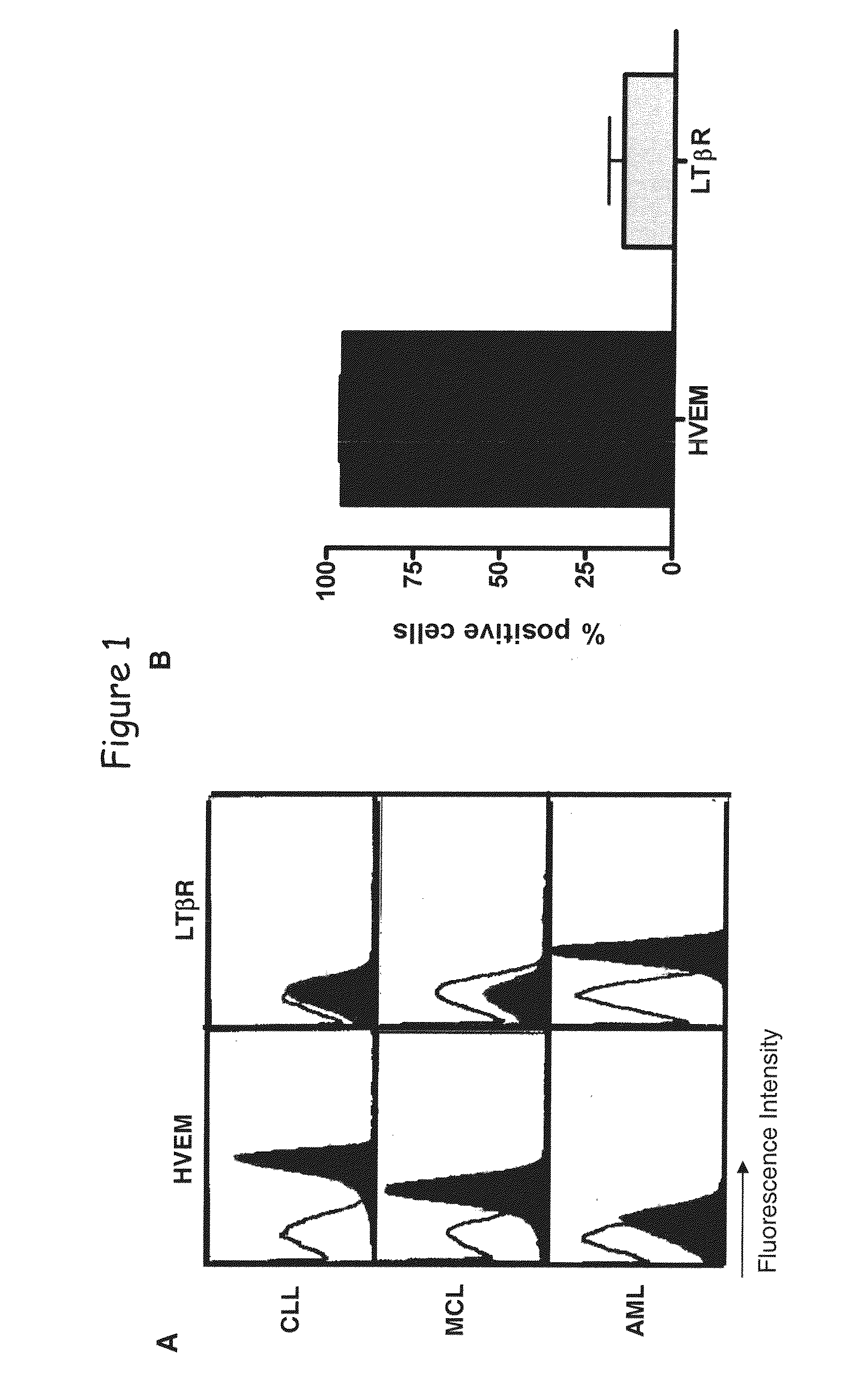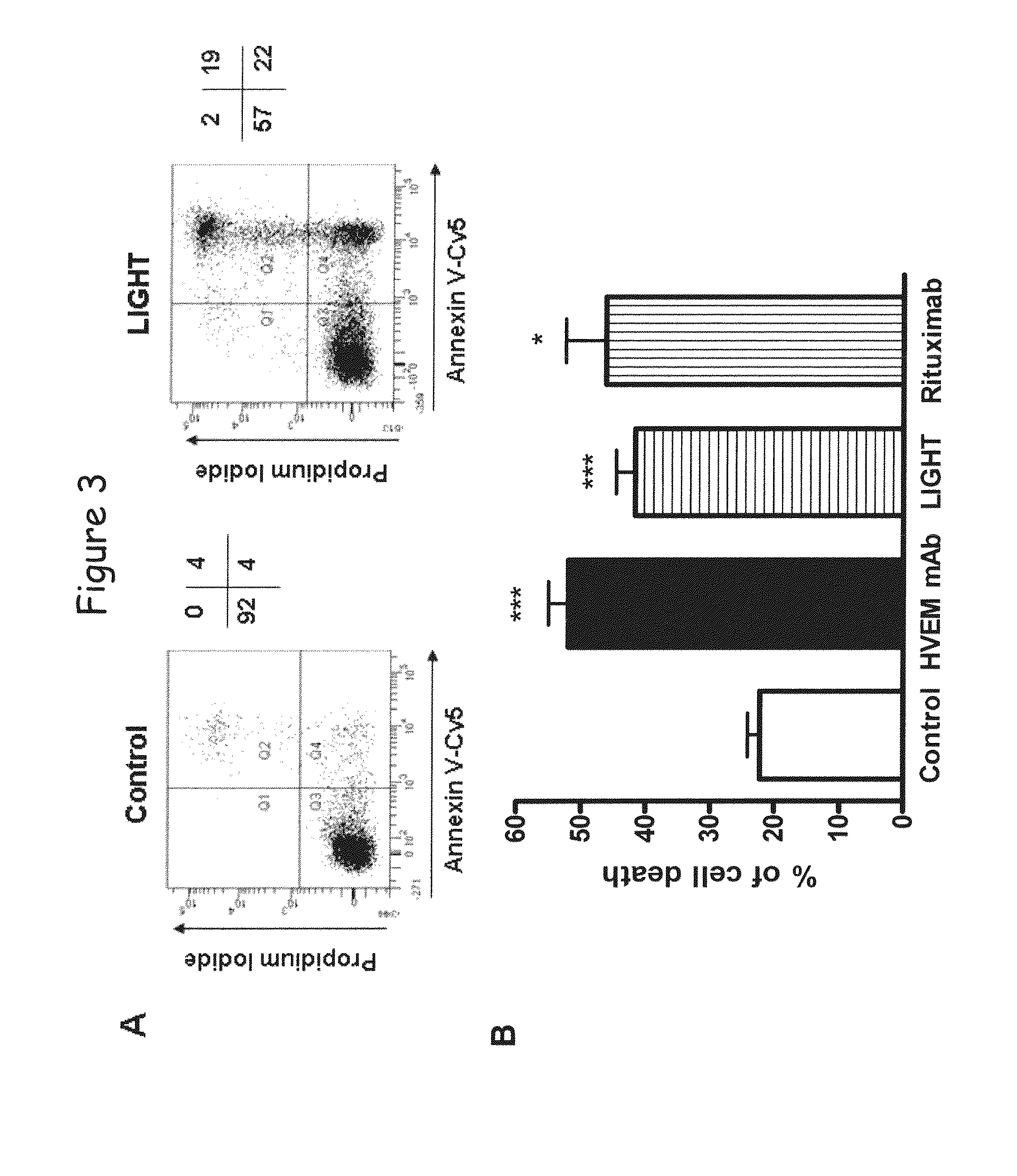Ligands of hvem for treating hematologic malignancies and autoimmune diseases
a technology of hematologic malignancies and antibodies, applied in the field of ligands of hvem, can solve the problems of accelerating morbidity and mortality, side effects and complications, and inability to respond to many patients, and achieve the effect of reducing the immunogenicity of antibodies
- Summary
- Abstract
- Description
- Claims
- Application Information
AI Technical Summary
Benefits of technology
Problems solved by technology
Method used
Image
Examples
example 1
LIGHT and Anti-HVEM Antibodies Induce Both Apoptosis of Chronic Lymphocytic Leukemia B Cells and Chemokine Release Through Interaction with HVEM
Abstract
[0144]By studying the effect of LIGHT in the global transcriptional profile of a lymphoid malignancy, we found that HVEM but not LTβR stimulation induced a significant increase of chemokine genes, such as IL-8, and an unexpected upregulation of apoptotic genes. This apoptotic transcriptional profile was associated with a killing effect, as LIGHT or anti-HVEM mAb, until yet known to costimulate T- and B-cell activation, clearly induced chronic lymphocytic leukemia (CLL) cell death. This cell death was associated with activation of caspase-3, -8 and -9, decrease in mitochondrial membrane potential, and upregulation of the proapoptotic protein Bax. Moreover, HVEM stimulation induced upregulation of the death molecules TRAIL and Fas, and the HVEM-mediated apoptotic mechanism seems to depend in part of the TRAIL pathway. HVEM stimulation ...
example 2
Characterization of Anti-HVEM mAb Clones
[0178]mAbs:
[0179]BALB / c mice were immunised by IP injection of human HVEM-Ig fusion protein, after the last injection the spleen cells were fused with X63Ag8 myeloma cells according to standard procedures. The hybridoma supernatants were screened by cell surface staining of human HVEM cells lines.
[0180]Fourteen mAb clones were characterized for a number of methods including: i) typing of the mouse immunoglobulin heavy and light chain types, ii) flow cytometry analysis for binding cell surface HVEM and determination of mean fluorescent intensity (MFI) values, maximum saturation binding, and 50% saturation binding (EC50 value), iii) competitive blocking studies with LIGHT, BTLA and HSV-gD, iv) mutagenesis analysis through binding of mAbs to a panel of HVEM mutants, and v) the ability of the mAb to induce apoptosis of CLL cells. Based on criteria from the competitive blocking and mutagenesis experiments, six epitope clusters were identified as ep...
example 3
HVEM is Expressed in Hematogical Malignancies
[0181]Flow cytometry analysis shows that HVEM is expressed as determined on B-cell lymphoid neoplasm (see FIG. 8) as well as T-cell lymphoid neoplasms, non-Hodgkin lymphoma (NHL), B-NHL, T-NHL, chronic lymphocytic leukemia (CLL), small lymphocytic lymphoma (SLL), mantle cell lymphoma (MCL), NK-cell lymphoid neoplasm and myeloid cell lineage neoplasm (data not shown).
[0182]Specimens of the different leukemias myeloma and myeloma were frozen and tested by flow cytometry for the cell surface expression of HVEM. Data are expressed as fold mean fluorescence intensity in comparison to negative control. CLL correspond to chronic B cell leukemia, ALL to acute lymphocytic leukemia, MM to multiple myeloma cells, MCL to mantle cell lymphoma, FL to follicular lymphoma and diffuse LBCL to diffuse large B cell lymphoma.
PUM
| Property | Measurement | Unit |
|---|---|---|
| Cytotoxicity | aaaaa | aaaaa |
Abstract
Description
Claims
Application Information
 Login to View More
Login to View More - R&D
- Intellectual Property
- Life Sciences
- Materials
- Tech Scout
- Unparalleled Data Quality
- Higher Quality Content
- 60% Fewer Hallucinations
Browse by: Latest US Patents, China's latest patents, Technical Efficacy Thesaurus, Application Domain, Technology Topic, Popular Technical Reports.
© 2025 PatSnap. All rights reserved.Legal|Privacy policy|Modern Slavery Act Transparency Statement|Sitemap|About US| Contact US: help@patsnap.com



